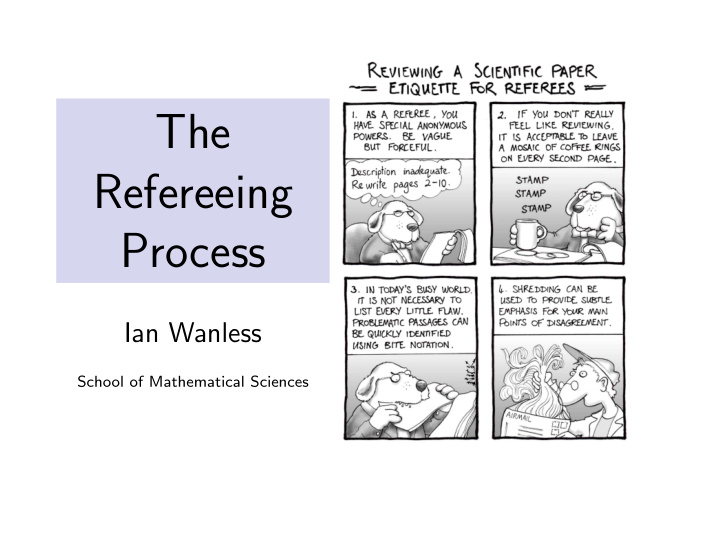



The Refereeing Process Ian Wanless School of Mathematical Sciences
The referee’s job ◮ Quality control ◮ Check correctness ◮ Judge originality ◮ Judge importance ◮ Summarise for the editor ◮ Point out missing literature ◮ Gauge suitability for the journal ◮ Comment on language and readability
Who are the referees? ◮ Usually one or two experts ◮ Chosen by the editor ◮ Academics like you ◮ Volunteers ◮ Busy people ◮ Clever people ◮ People (sometimes biased, vain, annoying, incompetent etc.)
What does the referee get out of it ◮ Warm inner glow from doing their duty ◮ May learn something about ◮ the subject ◮ how to write papers ◮ Get news of discoveries earlier ◮ Kudos ◮ Can put on CV which journals you’ve refereed for ◮ Impress the editors
Pitfalls to avoid ◮ Stealing ideas ◮ Breaching confidentiality ◮ Revealing your identity ◮ Accepting something you aren’t interested in or qualified for ◮ Taking too long ◮ Conflicts of interest ◮ Personal ◮ Professional ◮ Imposing your prejudices ◮ Writing the paper for them ◮ Becoming a co-author
How to deal with awkward reports ◮ Let off steam ◮ Ask yourself why they said that ◮ Don’t argue with the umpire ◮ Make all changes that you can stomach ◮ Justify not making other changes ◮ Realise if one person has misunderstood, others will ◮ Be polite
Do your referees a favour ◮ Structure your paper ◮ Make your motivation clear ◮ Write clear short sentences ◮ Introduce ideas in logical order ◮ Get feedback before submission ◮ If your English is weak, get assistance ◮ Beware ambiguity ◮ Proofread ◮ Proofread again!
Recommend
More recommend